
HERE at Performance Car of the Year, grins are king. This isn’t a test where a field of cars are ranked by a complex formula. And it ain’t about counting USB ports.
It’s about revealing what a calculator, spec sheet, or passenger seat can’t: how a car makes you feel when driven hard. There’s no price ceiling and the doors are open to the year’s standout driving machines. We’ve kept the competitive set small, but it doesn’t make finalising the list any easier. Despite louder calls for efficient this and safer that, froth-worthy cars are in abundance.
Those of you who caught last year’s event might notice a lack of supercars this time. We did ask around, but Ferrari’s 812 Superfast hadn’t quite reached Aussie shores, McLaren couldn’t find us an available 720S, and ditto Lamborghini and its Aventador S or Huracan Performante. That hasn’t slowed the class, though.
This might be the Nissan R35 GT-R’s fourth Performance Car of the Year appearance (2009, 2011 and 2017), but in Nismo trim it’s out to prove there’s still plenty of fight left in the now decade-old platform.
 Turbines pinched from the GT3 racer plump its 3.8-litre twin-turbo V6 by another 22kW and 20Nm, good for 441kW and 652Nm in total. Overhauled suspension also presses lighter, wider Rays alloys with Dunlop rubber into the tarmac.
Turbines pinched from the GT3 racer plump its 3.8-litre twin-turbo V6 by another 22kW and 20Nm, good for 441kW and 652Nm in total. Overhauled suspension also presses lighter, wider Rays alloys with Dunlop rubber into the tarmac.
Meanwhile, an angrier aero package skirts around it with red-striped carbon fibre. You’ll pay $299,000 for it to be parked in your driveway, more than anything else here. It’ll be kept honest by Mercedes-AMG’s new E63 S, now that the brand’s figured out how to fit front driveshafts in the nose of right-hand drive cars.
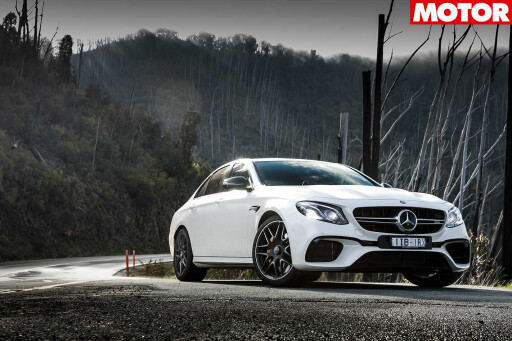 Purists may gasp, but word is the extra grip has made it a brilliant all-rounder. Oh, and AMG’s commonplace 4.0-litre twin-turbo V8 now packs V12-shaming outputs, with 450kW and 850Nm on offer. It’ll tear apart the drag strip, no doubt, but we’re keen to see how it’ll grapple with its two-tonne kerb weight in a dynamic environment.
Purists may gasp, but word is the extra grip has made it a brilliant all-rounder. Oh, and AMG’s commonplace 4.0-litre twin-turbo V8 now packs V12-shaming outputs, with 450kW and 850Nm on offer. It’ll tear apart the drag strip, no doubt, but we’re keen to see how it’ll grapple with its two-tonne kerb weight in a dynamic environment.
Launching it at a racetrack suggests AMG is confident the air-sprung, rear-drive biased, all-paw sedan does well. While drift-mode promises it hasn’t gone soft on its rear-tyre policy, either. Which is in stark contrast to our next all-wheel drive steed, the Audi TT RS.
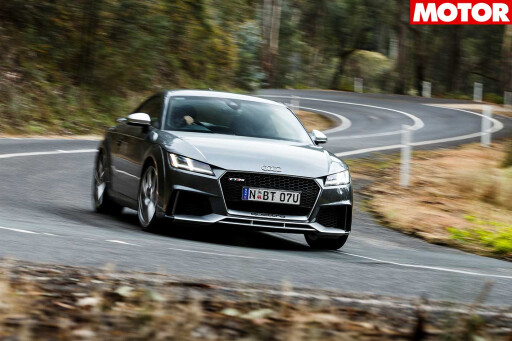 It has changed platform, engine, and looks since it last attended in 2012 to raise its threat of serious speed and fool-proof handling. There’s no drift-mode, but its heavily boosted straight-five is claimed to help the little two-door fire to 100km/h in 3.7sec.
It has changed platform, engine, and looks since it last attended in 2012 to raise its threat of serious speed and fool-proof handling. There’s no drift-mode, but its heavily boosted straight-five is claimed to help the little two-door fire to 100km/h in 3.7sec.
A new aluminium block and larger turbo haven’t mucked with its firing order and only enhanced its signature blare, which should no doubt help it stand out from the pack. The Audi clashes in size, pace, and price (sorta) with Porsche’s 718 Cayman S.
 While the brand wanted to have its new 911 GT3 here, it hadn’t landed. And as consolation, the four-cylinder Cayman finally packs the grunt we’ve professed its chassis could handle. Sure, the old six-cylinder’s velvety pipes might seem like a heavy trade for 18kW and 50Nm (for 257kW and 420Nm in all), but an optional rear limited-slip diff with torque vectoring, active drivetrain mounts, and PDK ’box keep this example a serious contender.
While the brand wanted to have its new 911 GT3 here, it hadn’t landed. And as consolation, the four-cylinder Cayman finally packs the grunt we’ve professed its chassis could handle. Sure, the old six-cylinder’s velvety pipes might seem like a heavy trade for 18kW and 50Nm (for 257kW and 420Nm in all), but an optional rear limited-slip diff with torque vectoring, active drivetrain mounts, and PDK ’box keep this example a serious contender.
Rounding out the German contingent is the BMW M4 CS. Just when everyone thought Munich could do no wrong after the E46 M3 and its V8-powered successor, the turbocharged M4 arrived at PCOTY in 2015 as a huge surprise. It was fast, but many believed the speed came at a the cost of a soulful engine and communicative handling.
 BMW has been slaving to find a fix and the CS dawns as a breakthrough. It doesn’t look as dramatic as the disappointing GTS we drove earlier in 2017, which also inspired the CS’s interior, but comes with a promising ingredients list.
BMW has been slaving to find a fix and the CS dawns as a breakthrough. It doesn’t look as dramatic as the disappointing GTS we drove earlier in 2017, which also inspired the CS’s interior, but comes with a promising ingredients list.
It starts with an M4 Competition and adds lightweight wheels, gluey Michelin tyres, suspension tweaks, and an extra 50Nm (for a massive 600Nm) – changes said to unlock more speed and transform the car’s nature.
Speaking of transformations, it’s no secret Lexus is trying to change its image. And the LC500 is its latest move to ditch the cardigan crowd and unearth a new one.
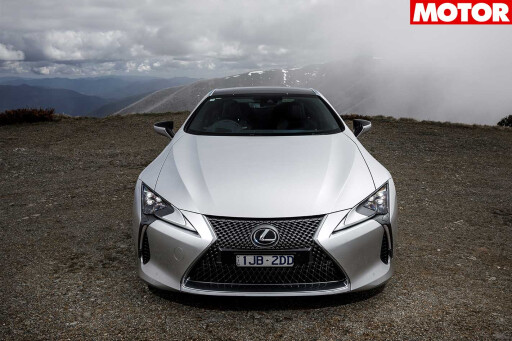 It’s a looker, and with a 5.0-litre V8 sending 351kW and 540Nm to the rear axle, it’s a goer as well. But this 6 Series challenger is not a stretched and re-panelled RC F by any means. Lexus has thrown the kitchen sink, plug, and drying rack at it, debuting an all-new platform, new front and rear suspension, and 10-speed transmission under its skin. Then there’s the noise.
It’s a looker, and with a 5.0-litre V8 sending 351kW and 540Nm to the rear axle, it’s a goer as well. But this 6 Series challenger is not a stretched and re-panelled RC F by any means. Lexus has thrown the kitchen sink, plug, and drying rack at it, debuting an all-new platform, new front and rear suspension, and 10-speed transmission under its skin. Then there’s the noise.
Tuned by the same team behind the LFA’s spine-tingling banshee wail, the LC500 certainly makes a song about being the only car to use a naturally aspirated engine. As for a dance? It might struggle as it nears two tonnes.
Meanwhile Honda has followed the NSX with a new Civic Type R which we’ve found to be rather good. Sure, it doesn’t scream, rattle, and shake your bones like the visceral road rockets of old, but that’s sort of the point. It’s an entirely new type of beast.
 Turbocharging has quietened its 2.0-litre VTEC engine, adaptive suspension has soothed its ride, and it’s embraced electronic assistance like a religion. But this hasn’t doused its pace one bit.
Turbocharging has quietened its 2.0-litre VTEC engine, adaptive suspension has soothed its ride, and it’s embraced electronic assistance like a religion. But this hasn’t doused its pace one bit.
The new Honda Civic Type R drives as wicked as it looks and it’ll be out for much more expensive scalps. Do not overlook this value-focused front-driver.
You can also add Alfa Romeo to the list of brands rediscovering its mojo. The Giulia is the first model to arrive on the company’s big-dollar Giorgio platform and it has even accosted Ferrari engineers to get things right. And boy, have they ever.
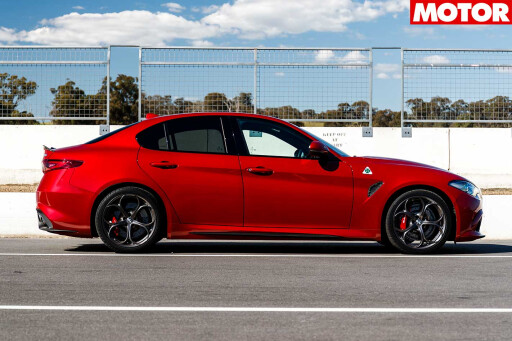 In Quadrifoglio Verde guise our Giulia packs a 2.9-litre V6 and two turbos, channelling a brawny 375kW and 600Nm to an electronically controlled fluid-locking rear diff. It’s not as fast as a BMW M3, or thunderous as a C63, but the Giulia has proved more accessible. A big part of what PCOTY’s all about. Which brings us to our last two entrants.
In Quadrifoglio Verde guise our Giulia packs a 2.9-litre V6 and two turbos, channelling a brawny 375kW and 600Nm to an electronically controlled fluid-locking rear diff. It’s not as fast as a BMW M3, or thunderous as a C63, but the Giulia has proved more accessible. A big part of what PCOTY’s all about. Which brings us to our last two entrants.
If you desire a rear-drive performance sedan with a twin-turbo six, Kia has you covered for about a third of the price. Yep, the brand has made PCOTY history with its liftback sedan called the Stinger. With 272kW and 510Nm you could say the well-built South Korean spiritually succeeds the Ford Falcon G6E Turbo.
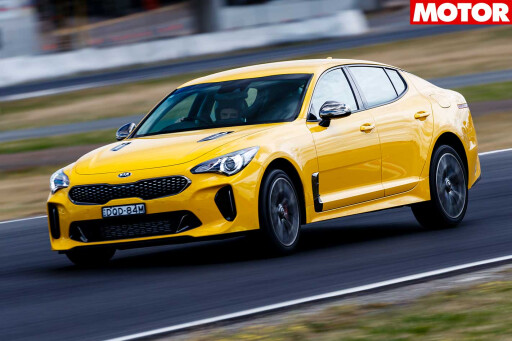 We went for the Si because it still gets staggered 19-inch tyres, an LSD and Brembo brakes, combined with a fixed suspension setup that strikes a better ride and handling balance than the top-shelf GT’s adaptive system, despite losing some stiffness.
We went for the Si because it still gets staggered 19-inch tyres, an LSD and Brembo brakes, combined with a fixed suspension setup that strikes a better ride and handling balance than the top-shelf GT’s adaptive system, despite losing some stiffness.
Just as Korea makes its first appearance, Australia makes its last. We’d be crying into our VB if the HSV GTSR W1 wasn’t the most expensive, powerful, and fastest local car ever. But thankfully it is.
Admittedly it was hard to look past the already brilliant base GTSR with widened front tracks and over-sized brakes after it beguiled us earlier this year. But the idea of uncorking a 600-horsepower-plus factory-built Commodore with Supercar-aping suspension, and semi-slicks on top of that, was too enticing. Could you blame us?
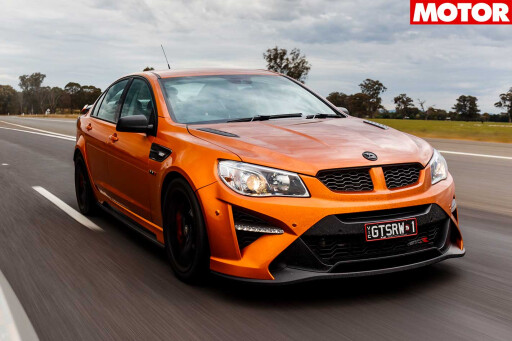 Add that HSV was willing to put a W1 back on its press fleet so we could measure it against the best performance cars from around the world and suddenly picking the $169,900 halo car felt like our national duty – you’re welcome.
Add that HSV was willing to put a W1 back on its press fleet so we could measure it against the best performance cars from around the world and suddenly picking the $169,900 halo car felt like our national duty – you’re welcome.
Stow the tinfoil hat, though, because emotional attachment won’t do the W1 any favours. Mystique fades quickly in groups this large and also under a schedule as gruelling as PCOTY’s.
The only downside to this was that we had to reluctantly ask Luffy to sit this one out (we’ll explain later). Reigning Bathurst 1000 champ David Reynolds was called instead to expose our other judges’ lack of talent.
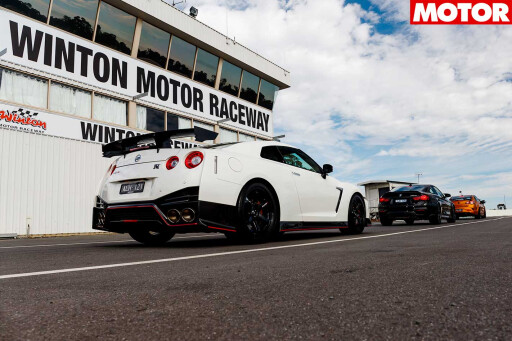 They’re joined by MOTOR’s eagle-eyed photographers and Victoria’s unpredictable weather on the way to Winton Raceway, for drag strip and racetrack duties, before we base ourselves in the ski-town of Bright.
They’re joined by MOTOR’s eagle-eyed photographers and Victoria’s unpredictable weather on the way to Winton Raceway, for drag strip and racetrack duties, before we base ourselves in the ski-town of Bright.
A day at DECA Shepparton’s road course was shelved, too, in exchange for more time on Mount Hotham’s breathtaking roads. Vans with tyres, coolant and oil won’t follow us either. Our 10 will be at the mercy of their own reliability and engineering. We’ll then have a think, add the judges’ scores (see caption and above), so you can bet on drama and a hard-fought win by the end of it all.
So, without further ado, welcome to Performance Car of the Year 2018.
UNUSUAL SUSPECTS - Meet the PCOTY judges
 (from left)
(from left)
Dylan Campbell
‘DC’ manages to juggle running this event and flogging cars with such calm that Gandhi would be curious as to his meditation routine
Tim Robson
Despite ditching this ship for freelance life, Robbo finds the PCOTY call too hard to resist. Lists ‘babysitter duty’ on invoices
Scott Newman
Will try to drift your gran’s mobility chair if given the reins. Our resident rally-man is always keen, and capable, of proving a pair of hands is the best form of ESP
David Reynolds
After placing a Brock trophy in his cabinet, he’s the only bloke actually paid to wear race boots. Tolerant of fools, evidently
David Morley
The depth of Morley’s wisdom is matched only by the volume of his nightly snoring. Starting to amass a large modern classics collection
HARD MARKERS - How we'll score each car
1 - Performance
Raw speed; powertrain response, feel, and smoothness
 2 - Dynamics
2 - Dynamics
Grip, chassis balance, steering response, and braking ability
3 - Accessibility
Effort versus reward, ESP calibration, feedback levels
4 - Liveability
Road noise, ride comfort, ergonomics, visibility, interior
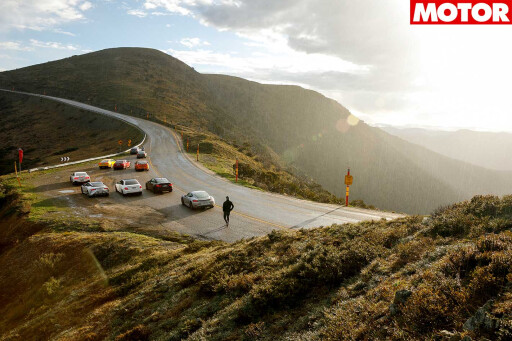 5 - Value
5 - Value
Price, cost of options, performance offered
6 - "X-Factor"
Styling, exhaust note, how badly you want one in your garage

COMMENTS